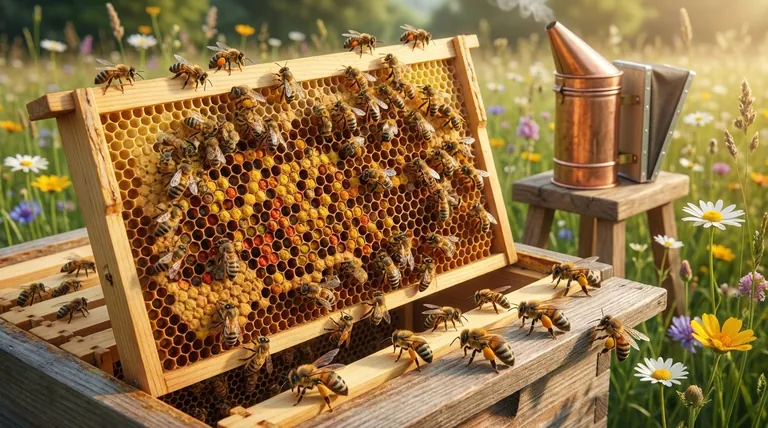In a single year, a strong, productive honey bee colony can consume a remarkable amount of pollen. Under conditions of intensive management, this figure can exceed 50 kilograms, or roughly 110 pounds. This volume is not a trivial matter; it is the fundamental resource that fuels the growth and resilience of the entire hive.
Pollen consumption is not a measure of hunger, but a direct indicator of a colony's reproductive output. The massive quantity a hive consumes is tied directly to the number of young bees (brood) it must raise, making pollen the essential protein source for building the next generation.

Why Pollen is the Engine of the Colony
To understand the high consumption rate, you must first understand the role of pollen. While nectar (honey) provides carbohydrates for energy, pollen provides everything else required to build a bee.
The Essential Protein Source
Pollen is the honey bee's only natural source of protein, lipids, vitamins, and minerals. Nurse bees consume it to produce royal jelly and worker jelly, the nutrient-rich food fed to the queen and developing larvae.
Fueling Brood Development
A single larva requires a substantial amount of pollen to develop into a healthy adult bee. The colony's annual pollen need is therefore a direct reflection of its brood-rearing activity. More brood means more pollen is required.
Creating "Bee Bread"
Foragers bring pollen back to the hive, where it is packed into cells and mixed with nectar and enzymes. This mixture ferments into a preserved food source known as bee bread, which serves as the colony's protein pantry.
Factors That Drive Pollen Consumption
The "50 kg" figure is a high-end estimate. The actual amount a colony consumes varies significantly based on several key factors.
Colony Size and Strength
A larger, more populous colony simply has more mouths to feed. A hive with 60,000 bees and a prolific queen will consume vastly more pollen than a smaller colony of 20,000 bees.
Brood Rearing Cycles
Pollen consumption is not constant throughout the year. It peaks dramatically in the spring and early summer when the queen is laying at her maximum rate—often over 1,500 eggs per day. Consumption drops significantly in the fall and is minimal during the winter.
The Role of "Intensive Management"
The term "intensively managed" is key. This refers to beekeeping practices designed to maximize colony population for goals like honey production or pollination services. Such management keeps the brood cycle running at full throttle for longer, driving up total pollen demand.
Understanding the Trade-offs: When Supply is Limited
A high pollen intake is a sign of a thriving colony, but a lack of pollen can have severe consequences. This period of scarcity is known as a pollen dearth.
Reduced Brood Rearing
When pollen stores run low, the colony's first response is to conserve resources. Nurse bees produce less brood food, and the queen will dramatically slow or even stop laying eggs. This shrinks the future workforce of the hive.
Weakened Adult Bees
Adult bees deprived of adequate protein have shorter lifespans and compromised immune systems. This makes the entire colony more vulnerable to diseases, parasites like the Varroa mite, and pesticide exposure.
Cannibalism of Eggs and Larvae
In extreme cases of protein stress, nurse bees may resort to cannibalizing younger eggs and larvae. This drastic measure allows them to recycle the protein to feed the more mature, viable brood.
Making the Right Choice for Your Goal
Understanding your colony's pollen needs is central to effective beekeeping and supporting bee health. How you apply this knowledge depends on your objective.
- If your primary focus is honey production: High pollen intake in the spring is non-negotiable, as it is required to build the massive forager population needed to capitalize on the summer nectar flow.
- If your primary focus is pollination services: You must ensure colonies are strong and actively brood-rearing, which demands consistent and abundant pollen access, often requiring supplemental feeding with pollen patties.
- If your primary focus is overall colony health: Monitor your hive's stored bee bread and the diversity of pollen sources in your area to anticipate and prevent nutritional stress before it weakens the colony.
By understanding the colony's demand for pollen, you transition from simply keeping bees to actively cultivating a thriving, resilient hive.
Summary Table:
| Key Factor | Impact on Pollen Consumption |
|---|---|
| Colony Size | Larger colonies (>60k bees) require significantly more pollen. |
| Brood Rearing | Peaks in spring/summer; can exceed 50 kg under intensive management. |
| Management Style | Intensive practices (e.g., for honey/pollination) maximize consumption. |
| Pollen Dearth | Scarcity leads to reduced brood, weakened bees, and colony decline. |
Ensure your apiary thrives with optimal nutrition! At HONESTBEE, we supply high-quality beekeeping supplies and equipment—including pollen supplements and feeders—to commercial apiaries and distributors. Let us help you support robust brood development and maximize hive productivity. Contact us today to discuss your wholesale needs!
Visual Guide

Related Products
- Premium Traditional Copper Bee Smoker with Bellows
- Professional Galvanized Hive Strap with Secure Locking Buckle for Beekeeping
- Oxalic Acid Vaporizer 12V for Bee Varroa Mite Treatment
- Stainless Steel Honey Bee Smoker Hive and Honeycomb Smoker for Beekeeping
- Wooden Queen Bee Excluder for Beekeeping
People Also Ask
- How did early beekeepers use bee smokers? Master Ancient Bee Calming Techniques
- What is a Smoker and how is it used in beekeeping? The Essential Tool for Calm, Safe Hive Inspections
- What are some alternatives to using smoke in beekeeping? A Guide to Gentle Hive Management
- What happens to bees when they sense smoke? Unlock the Secret to Calm Hive Inspections
- How does water mist work as an alternative to smoke in beehives? A Guide to Safe & Effective Use



















